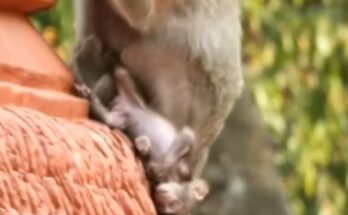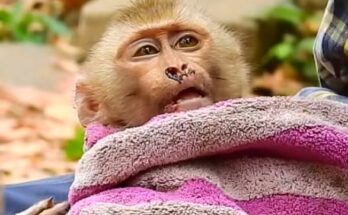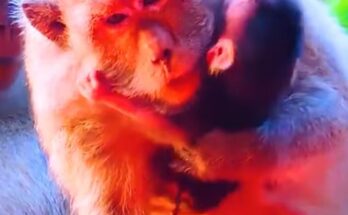In the quiet canopy of a tropical forest, a poignant and heart-wrenching scene unfolds—one that reflects the profound emotional depth found in the animal kingdom. A mother monkey, her movements slow and deliberate, cradles the limp body of her lifeless infant. She clings to the tiny form with a tenderness that speaks volumes of love, grief, and perhaps even denial. This somber walk through the trees is not just a journey through space, but through sorrow—an intimate ritual of mourning that echoes the human experience of loss.
Primates, our closest animal relatives, are known to express complex emotions. In this case, the grieving mother monkey exhibits behavior that scientists and observers interpret as mourning. She carries her deceased infant for hours, sometimes days, grooming it gently, as if willing it to awaken. Her eyes scan the surroundings, but her focus always returns to the small body in her arms. This final walk is not for nourishment or protection—it is a heartbreaking act of love and memory.
Such behavior has been observed in several monkey species, including baboons, macaques, and vervets, as well as in great apes like chimpanzees and gorillas. While the specific motivations remain scientifically uncertain, many ethologists believe these maternal acts represent grief and an inability to immediately let go. The mother may be trying to understand what has happened, or she may be demonstrating the deep biological and emotional connection between mother and child.
In a way, this ritual reflects a shared emotional language between humans and other primates. Grief is not exclusive to our species. The pain of loss, the confusion, and the need to hold on are universal in the mammalian world. This final walk—the act of carrying the lifeless infant—is not just a refusal to accept death, but perhaps an honoring of life. The mother monkey, in her silent mourning, teaches us that love and loss exist far beyond the boundaries of human understanding.
The forest itself seems to pause in the presence of this raw sorrow. The usual chatter of birds and rustle of leaves give way to a reverent hush. Fellow troop members often acknowledge the deceased infant, approaching the mother with cautious touches or lingering gazes. Sometimes, they sit quietly nearby, bearing witness. This communal awareness suggests that mourning may be a shared experience, not only between mother and infant but within the broader group dynamic.
“Tears in the Trees” is not a tale of science alone, but of shared sentience. It compels us to reconsider how we view nonhuman animals—not as instinct-driven creatures, but as beings capable of emotional depth, attachment, and even spiritual expression. The mother monkey’s final walk, etched in the memory of those who witness it, becomes a powerful symbol of maternal devotion and the universality of grief.
In her arms, the body of her infant is more than a lifeless form—it is a piece of her heart, carried through the trees one last time.


